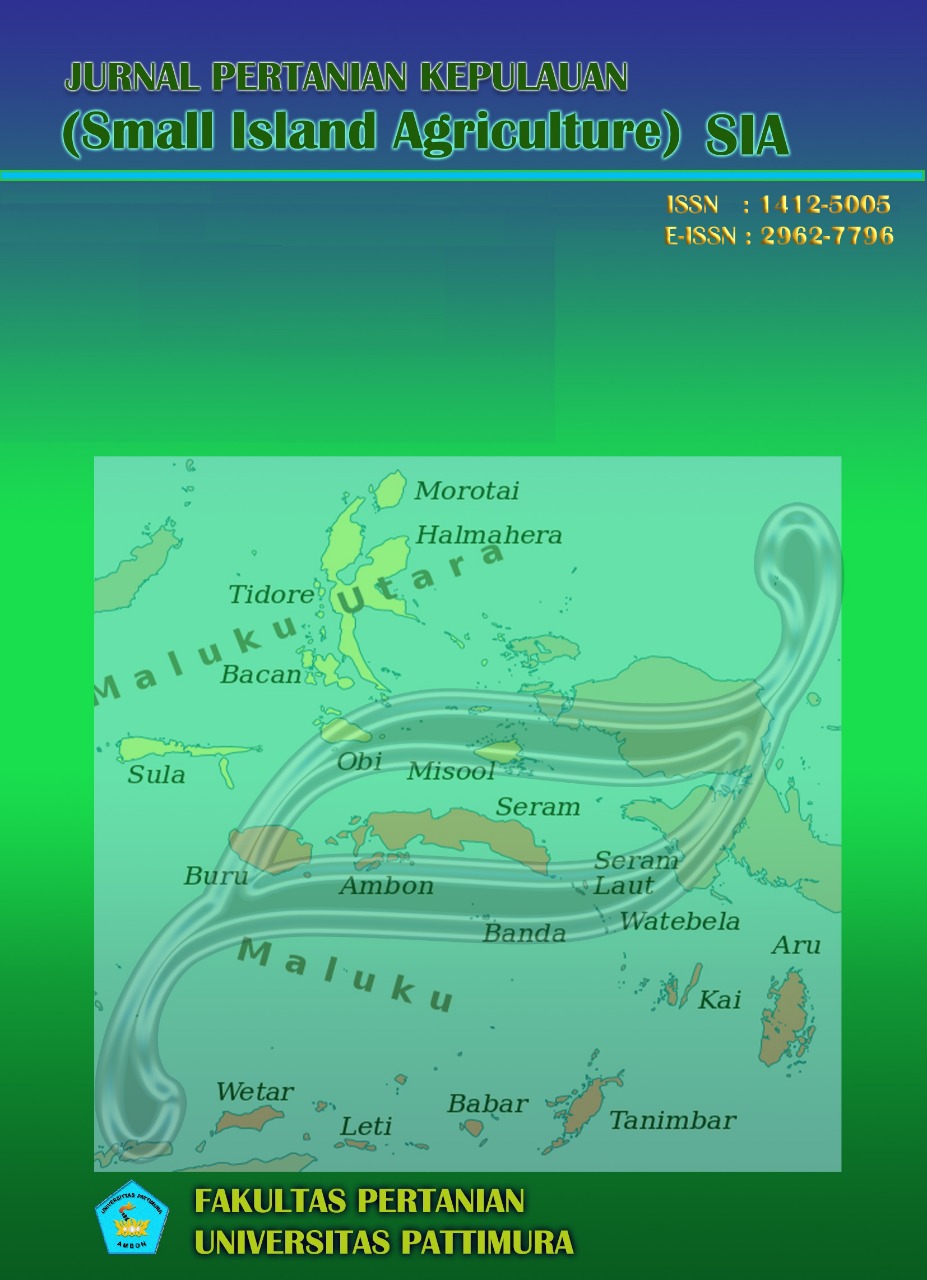Analisis Musim Tanam dan Pengaturan Pola Tanam Tanaman Pangan pada Berbagai Kondisi Curah Hujan di Daerah Amahai Kabupaten Maluku Tengah
Abstract
Cropping patterning is an farming practice to obtain maximum production taking into account climatic conditions, soil and types of crops cultivated. This research, which was carried out in the Amahai Region, aimed to: (i) describe extreme climate events and (ii) determine the growing season and cropping patterns of food crops based on the length of the growing season available in the region. The analytical methods used consisted of: (i) determining extreme rainfall based on BMKG standards and ENSO History data, (ii) determining the planting season using the FAO method, and determining cropping patterns in conditions of extreme rainfall. The results showed that a very extreme El Nino event caused a decrease in rainfall in the Amahai region by 1,444 mm or 54% of its normal condition, on whereas a very extreme La Nina event caused an increase in rainfall by 1,528 mm or 60% of its normal condition. The growing season in the Amahai region under conditions of average (normal) and La Nina rainfall is throughout the year (12 months), and under conditions of extreme El Nino rainfall, the growing season lasts for 8 months and 26 days, 96 days shorter than normal conditions. In conditions of extreme El Nino rainfall, the cropping patterns that can be applied are sequential, monoculture, and polyculture/ intercropping.
Downloads
References
[BALITKLIMAT] Balai Penelitian Agroklimat dan Hidrologi. (2008). Menentukan masa tanam yang tepat dengan kalender tanam.
[BMKG] Badan Meteorologi Klimatologi dan Geofisika. (2012). Verifikasi Prakiraan Iklim Indonesia.
Djadja Subardja, S., Ritung, S., Anda, M., Sukarman, Suryani, E., & Subandiono, R. . E. (2014). Petunjuk Teknis Klasifikasi Tanah Nasional (1st ed.). Balai Besar Penelitian dan Pengembangan Sumberdaya Lahan Pertanian, Badan Penelitian dan Pengembangan Pertanian.
Fadilla, L., Subiyanto, S., & Suprayogi, A. (2017). ANALISIS PENGARUH FENOMENA EL NINO DAN LA NINA TERHADAP CURAH HUJAN TAHUN 1998 - 2016 MENGGUNAKAN INDIKATOR ONI (OCEANIC NINO INDEX) (Studi Kasus : Provinsi Jawa Barat). Analisis Arah Dan Prediksi Persebaran Fisik Wilayah Kota Semarang Tahun 2029 Menggunakan Sistem Informasi Geografis Dan CA Markov Model, 6.
[FAO]. (1978). Methodology and results from Africa. Report on the Agro-Ecological Zones Project. Report No.48/I. FAO, Rome.
FAO. (2018). Cropwat (8.0). FAO.
Gezie, M. (2019). Farmer’s response to climate change and variability in Ethiopia: A review. In Cogent Food and Agriculture (Vol. 5, Issue 1). https://doi.org/10.1080/23311932.2019.1613770
Hendry, R. M., & Sudjianto, U. (2013). Pola tanam antisipasi perubahan iklim. Umk.Muria. http://infomuria.umk.ac.id
Hilman, Y., Suciantini, S., & Rosliani, R. (2019). ADAPTASI TANAMAN HORTIKULTURA TERHADAP PERUBAHAN IKLIMPADA LAHAN KERING Adaptation of Horticultural Crops to Climate Change in the Upland. Jurnal Penelitian Dan Pengembangan Pertanian, 38(1). https://doi.org/10.21082/jp3.v38n1.2019.p55-64
Kusnanto, H. (2011). Adaptasi Terhadap Perubahan Iklim. Yogyakarta: BPFE. BPFE.
Laimeheriwa, S. (2014). Analisis Tren Perubahan Curah Hujan pada Tiga Wilayah dengan Pola Hujan yang Berbeda di Provinsi Maluku. Jurnal Budidaya Pertanian. Jurnal Budidaya Pertanian, 10(2).
Laimeheriwa, S. (2015). Analisis data iklim dalam bidang pertanian: peluang curah hujan, masa tanam, neraca air lahan dan klasifikasi iklim wilayah. Bahan ajar agroklimatologi. In Fakultas Pertanian, Unpatti.
Laimeheriwa, S., Pangaribuan, M., & Amba, M. (2019). Analisis Fenomena El Nino dan Dampaknya Terhadap Neraca Air Lahan di Pulau Ambon. JURNAL BUDIDAYA PERTANIAN, 15(2). https://doi.org/10.30598/jbdp.2019.15.2.111
Lidjang, I. K., Yusuf, & Nulik, J. (2006). Analisis Kebijakan Dampak Kekeringan di Kabupaten Sumba Timur. Prosiding Seminar Nasional Komunikasi Hasil-Hasil Penelitian Pertanian Dan Peternakan Dalam Sistem Usahatani Lahan Kering.
NOAA. (2021). DEPARTMENT OF COMMERCE National Oceanic and Atmospheric Administration. Federal Register, 86(102).
Nurdin, S. (2011). Antisipasi perubahan iklim untuk keberlanjutan ketahanan pangan. Jurnal Dialog Kebijakan Publik, 4, 21–31.
Oldeman. (1975). An agroclimatic map of Java. Contr. Centr. Res. Inst. Agric.
Oldeman, L. R., & Frere, M. (1982). A study of the agroclimatology of the humid tropics of South-East Asia. A Study of the Agroclimatology of the Humid Tropics of South-East Asia.
Tangang, F., Farzanmanesh, R., Mirzaei, A., Supari, Salimun, E., Jamaluddin, A. F., & Juneng, L. (2017). Characteristics of precipitation extremes in Malaysia associated with El Niño and La Niña events. International Journal of Climatology, 37. https://doi.org/10.1002/joc.5032
Uspessy, J. F., Laimeheriwa, S., & Patty, J. R. (2020). Penentuan Musim Tanam Berdasarkan Perhitungan Neraca Air Lahan di Daerah Saumlaki, Pulau Yamdena. JURNAL BUDIDAYA PERTANIAN, 16(2). https://doi.org/10.30598/jbdp.2020.16.2.173





.png)


